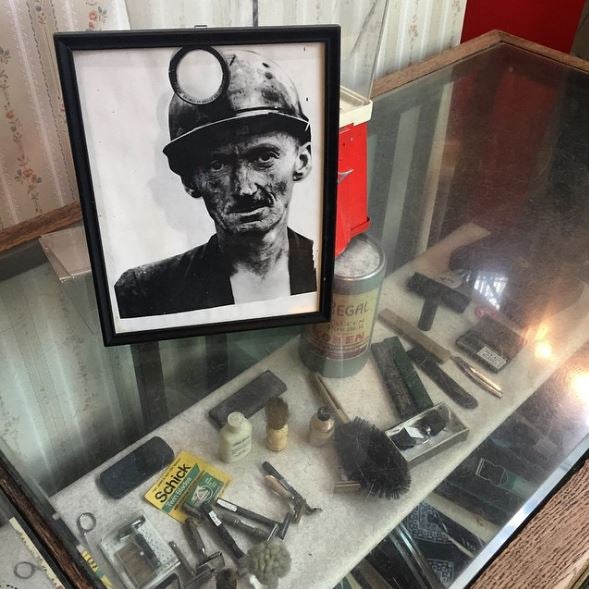Kentucky Coal Museum installs solar panels because it will save money
'We believe that this project will help save at least $8,000 to $10,000 off the energy costs on this building alone'

Housed in a former commissary building and tucked into the hollers of Harlan County — the heart of Kentucky mining country — is a museum dedicated to all aspects of extracting coal from the state’s mountains.
Mining equipment decorates its walls, while a two-ton block of coal at the front door greets visitors. Children can climb on the museum’s 1940s model electric locomotive that once carried Kentucky men into the mines. An exhibit dedicated to Loretta Lynn (who wrote and who is the “Coal Miner’s Daughter”) sits on the third floor. Guests can even wander through an actual underground coal mine.
Not much about the Kentucky Coal Mining Museum screams modern. Its website — nay, websites — boasts early 1990s Web design, and its advertisement on YouTube appears to have been shot on a handheld camcorder. It sits next to City Hall on Main Street, the only thoroughfare of Benham, Ky. That’s to be expected from a museum dedicated to an old form of energy, which is what makes its own power methods so interesting.
The museum is switching to solar power in hopes of saving money on energy costs, as reported by WYMT and EKB-TV. The installation of solar panels began this week.
“We believe that this project will help save at least $8,000 to $10,000 off the energy costs on this building alone, so it’s a very worthy effort and it’s going to save the college money in the long run,” Brandon Robinson, communications director of Southeast Kentucky Community and Technical College, which owns the museum, told WYMT.
Robinson wasn’t blind to the incongruity of a coal museum being powered by solar energy, asserting that there’s a symbiosis between the two.
“It is a little ironic,” said Robinson, “But you know, coal and solar and all the different energy sources work hand-in-hand. And, of course, coal is still king around here.”
As Tre’ Sexton, owner of Bluegrass Solar, told EKB-TV, the runoff power collected by the panels will be fed back into Benham’s power grid. The entire town of almost 500 that bills itself as “The Little Town That International Harvester, Coal Miners and Their Families Built!” will be partially run on solar power.
“I know the irony is pretty prevalent,” Sexton told EKB-TV. “But all the same, it is making a big difference, I think, for not only the museum, which will probably eliminate a lot of their overhead, but the city in general.”
“We’re happy to be able to hopefully provide some power to the city of Benham that we’re not using here,” Robinson told EKBTV. “So it’s a great project; it’s a great effort.”
It’s difficult not to see a foreshadowing in the switch to solar power.
About 85 percent of Harlan County voted for Donald Trump in the 2016 election. The disparity between Hillary Clinton’s and Trump’s campaign promises concerning energy almost assuredly played a factor in that vote.
While Clinton, speaking about renewable energy, infamously said, “We’re going to put a lot of coal miners and coal companies out of business,” Trump promised “sweeping deregulation” of the coal industry.
Trump’s plan struck a chord with some miners.
Former Harlan County coal miner Mark Gray, 58, recalled to the New York Times the moment a meeting was called at work: “They said we can’t go on with these regulations, we can’t go on with the way the government’s doing.”
Gray hoped Trump’s plan might help.
Solar Technology in the UK
Show all 7After all, coal mining was once a major American industry. In 1923, nearly 1 million of America’s 110 million citizens worked as coal miners. Now, the industry employs approximately 77,000 people, fewer employees than the Arby’s restaurant chain.
“It won’t ever be back the same,” Gray said. “But I hope some of the jobs come back and fix up little places like Harlan County.”
Last week, Trump indeed signed an executive order to roll back “several Obama-era environmental regulations that would have affected industries such as coal mining,” The Washington Post’s Christopher Ingraham reported.
“I made them this promise,” Trump said at the signing. “We will put our miners back to work.”
Experts, though, claim deregulation won’t be enough to bring back coal jobs. The hard truth, they say, is that nothing will.
The museum will, of course, still offer anyone passing through the hollers of Kentucky a glimpse into an industry that helped define part of America. Only it will be looking to the sky, rather than in the earth, to light the way.
Subscribe to Independent Premium to bookmark this article
Want to bookmark your favourite articles and stories to read or reference later? Start your Independent Premium subscription today.

Join our commenting forum
Join thought-provoking conversations, follow other Independent readers and see their replies